ENLIGHTENED THOUGHTS BECOME ACTIONS
Independence Hall,
Philadelphia
STOP: Complete Section A Questions.
Enlightened
Despots
While
the writers and philosophers of the Enlightenment were busy with their pens,
most kings and queens of continental Europe were ruling as absolute
monarchs. Absolutism gave these rulers total control over their governments
and their people. In some cases, this
included a vast amount of serfs or
peasants who were obligated to do work on the properties of the
landowners. Unlike slaves, they could
not be sold but were obligated to remain with the land. As the ideas of the Enlightenment spread,
many individuals began to question the authority of their leaders and the
conditions of the citizenry. They
concluded that the skill of critical thinking could be used to turn governing
into a science; this would result in the creation of better laws and useful reforms. The philosophes had a practical side, and
they knew it was unlikely that monarchs would give up their power
willingly. Therefore, it seemed that
enlightened despots or monarchs with a clear understanding of the philosophy of
the Enlightenment were the best hope of improving society.
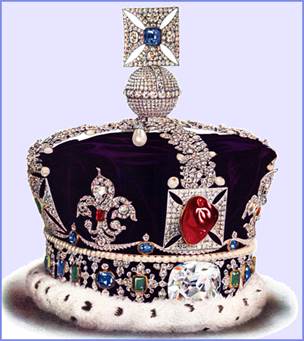
Imperial Crown of the
United Kingdom
How
did Europe’s rulers react to the ideas of the Enlightenment? Some, like King Louis XV of France, chose to ignore the whole movement and
censor the new writers. It was not an
effective practice, but it made them feel more secure. Other rulers, however, were caught up in the
spirit of the new thought and were impressed with the inspiring concepts
centered on reason and progress. These
enlightened despots often favored religious tolerance, legal reform and useful
projects. However, make no mistake, power politics always took precedence over
enlightened teaching. Let’s examine two
of the most prominent rulers who fit this description—King Frederick II of
Prussia and Empress Catherine II of Russia.
STOP: Complete Section B questions.
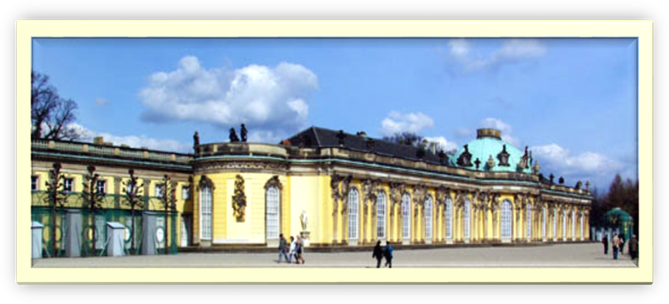
Palace built by Frederick the Great
King Frederick II of Prussia
Most of us would have enjoyed spending an afternoon
with Frederick II (also known as
Frederick the Great). He was witty,
brilliant and interested in almost everything.
Frederick lived modestly, at least by the standards set for the European
monarchs of his day, and he worked hard at the business of ruling. His attitude conveyed his desire to serve and
to strengthen the state, and his views were generally humane and liberal. Schools under his leadership improved, and
scholars were permitted to publish their findings. Religious tolerance of both Catholics and
Protestants became the norm.
However,
Frederick the Great never lost sight of the fact that the Prussian nobility was
the backbone of the army and the foundation of his power. This placed major limitations on his quest
for reform. For example, Frederick II
openly admitted that serfdom was wrong, but he did not want to offend wealthy
landowners by doing anything about it.
The concept of religious freedom did not extend to Polish and Prussian
Jews who were confined to small, overcrowded ghettos. Because he did not want to risk losing the
support of his military officers, Frederick reduced the use of torture but did
not abolish it. Although he preferred to
justify his reign with practical results and said little about divine right,
Frederick had no intention of jeopardizing his rule for the sake of the ideals
of the Enlightenment.
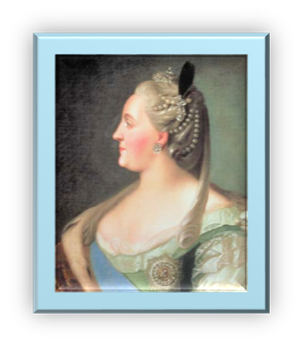
Catherine the Great
Empress Catherine II of Russia
One
of the most fascinating figures of the eighteenth century was Catherine II, Empress of Russia. Her thirty-four year reign was filled with
political challenges, intellectual advancements and intrigue. Influenced by the writers of the
Enlightenment, many of whom visited her court, Catherine called a
constitutional convention in 1767. She
invited nobles, townspeople and peasants in the hope of creating domestic
reform and new laws. However, when the
participants argued and accomplished very little, Catherine simply sent them
home and abandoned the whole idea of a constitution.
Although
she claimed to be an enlightened ruler, improving the lives of all the Russian
peasants conflicted with Catherine’s need to have the support of the
nobility. This became very obvious in
1773 when Catherine sent her armies to crush a massive uprising supported by
peasants, soldiers and escaped prisoners.
Catherine the Great was also committed to the territorial expansion of
her empire and, like her counterpart Frederick II of Prussia, ignored the
philosophe’s arguments against war. In
short, Catherine’s commitment to the teachings of the Enlightenment was more of
an intellectual pursuit than a political reality.
STOP: Complete Section C questions.
The
Enlightenment Crosses the Atlantic
In theory, Britain’s government, referred to as a limited monarchy, was considered the
best on the planet, at least according to the standards of the
Enlightenment. However, theory and
reality were two different things. The
king’s power was limited by a law-making body called Parliament. It was divided into two parts—the House of
Lords and the House of Commons. By its
very name, it seemed the House of
Commons should be a perfect example of democracy in action. Yes, its members were elected by popular
vote, but only men who owned the required amount of land were eligible to cast
a ballot. As a result, the House of
Commons was elected by five percent of the population. This small group of citizens favored
government policies that encouraged national economic expansion and individual
profits.
In
the eighteenth century, a country’s international status was directly related
to its gold supply. To accumulate gold,
a nation had to sell more products than it bought. The British concluded that
the key to prosperity was the establishment of colonies so they directed their
attention to winning and controlling them.
Britain directed colonial affairs based on the principle of mercantilism. This economic philosophy stressed the concept
that colonies existed primarily to enrich the mother country. In contrast, the American colonists saw
themselves as loyal British citizens who deserved the same rights and
privileges as their counterparts in Britain.
To understand how these differing views led to revolution, one needs to
simply follow the money.
STOP: Complete Section D questions.
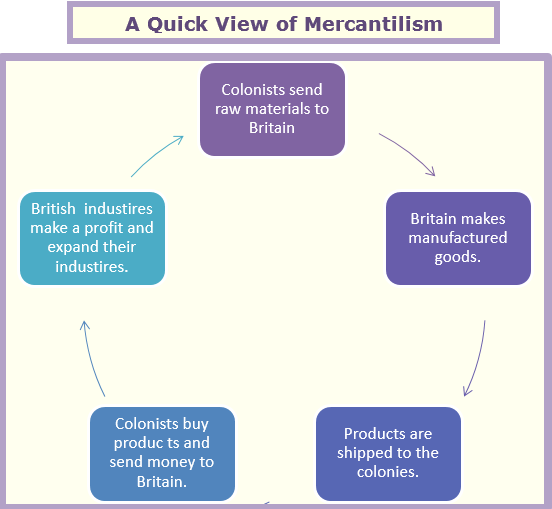
The
American colonies served as a ready market for British manufactured products
and a cheap source for materials shipped to Britain by the colonists. To assure the system worked to their benefit,
the British passed the Navigation Acts
in 1660 and 1663. According to these
laws, the Americans could not sell their most valuable products to any country
other than Britain and could and could only buy products from other countries
if they paid high taxes on them. In an
attempt to circumvent the law, the colonists resorted to smuggling, and it was
difficult for the British to control.
Political
events in Europe pulled Great Britain into the Seven Years’ War and drew battle lines between the British and
French settlers in North America. After
the British brought the war to a successful conclusion, they reasoned that the
colonies should be responsible for a portion of the war debt since they
benefitted from the expensive military campaigns. Britain reasoned that a new tax required of
the colonists was a logical consequence.
The Stamp Act, which required
the colonists to pay for the stamping of legal documents such as deed and
wills, was so vehemently opposed it had to be repealed. As the British continued their attempts to
tax the American portion of the Empire, the colonists began to see themselves
in terms of the ideals of the Enlightenment.
They used the concepts of John Locke and other philosophers to justify
their objections to the activities of the British crown.
Eventually,
the situation became intolerable, and the Americans wrote the Declaration of
Independence based on violations of the social contract. Once they won their independence, Americans
again used the Enlightenment principles to set up a new government. The thoughts of Rousseau, Locke and
Montesquieu resulted in a system that drew its authority from the consent of
the governed. The Constitution stressed
a form of leadership based on the separation and the balance of powers. It was indeed the Enlightenment philosophies
that drove the American Revolution and the establishment of a new
government. These developments strongly
reflected the Enlightenment beliefs of reason and progress.
STOP: Complete Section E questions.
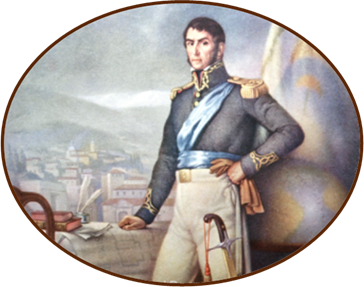
Jose de San Martin
The
Enlightenment Moves South
The
Enlightenment ideas also impacted events in the southern parts of the Western
Hemisphere. The countries that colonized
these lands (Portugal, Spain and France)
all spoke languages derived from Latin so the regions of the Caribbean, South
American, Central America and Mexico were referred to collectively as Latin America. The population ranged from the enormously
wealthy to the extremely poor. People
who were born in the mother countries and held the most important offices were
known as peninsulares. Their control of the valuable import and
export trade was responsible for much of their financial success. Ranked next were the creoles who were born in Latin America to parents of European
origin. Most were rich landowners and
held less important government offices.
These two groups made up a mere twenty percent of the populace. The vast majority of the inhabitants
consisted of mestizos (individuals
of a European and Indian background), mulattos
(individuals of European and African background) and native Indians. The millions of Indians were considered the
lowest in respect to social status. They
were technically free but were treated no better than slaves. Their plight came to the attention of King Charles III of Spain who fit the
mold of an enlightened despot. He made
an effort to introduce reforms to benefit the Indians. However, the distance between Spain and New
Spain, as Spanish lands in South America were called, was great; laws were
difficult to enforce if the peninsulares did not agree with them. The fear of an Indian revolt encouraged the
neglect of these laws.
In
the meantime, the ideas of the Enlightenment began to drift into Latin
America. North American ships visited
South American ports staffed with sailors who sometimes brought copies of the
American Declaration of Independence and the Constitution as well as the
writings of Voltaire and Rousseau. The
Creole elite became familiar with these works and came to believe that certain
rights should be extended to them.
Creoles began to think of themselves as Americans rather than Spaniards.
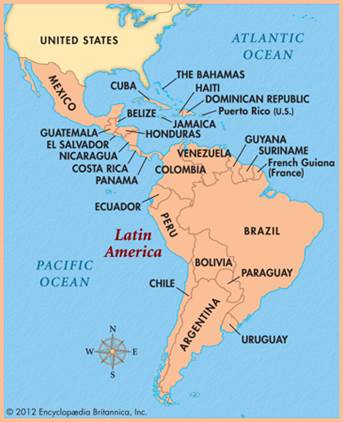
This
new trend in thought led to a series of revolutions in Latin America from 1810
to 1830 and brought to the forefront two brilliant generals inspired by the
ideals of the Enlightenment, their Creole backgrounds and events in Europe as
well as North America. Simon Bolivar, known as El Libertador,
was a well-educated and well-traveled Venezuelan Creole. Having read the writings of Voltaire and
Rousseau along with those of Jefferson and Paine, he led revolutionaries in
Venezuela, Ecuador and Colombia. Jose de San Martín guided the military
activities of the patriots in Chile and Argentina. Their combined forces eventually drove out
the Spanish forces and inspired other regions of Latin America to seek
independence as well.
Although
Latin America included sixteen independent nations by 1830, political freedom
and government by the consent of the governed proved to be elusive goals. Some military leaders had come to enjoy the
power they had achieved during the struggles for independence. This led to a rise in dictatorships in most
Latin American countries. These rulers
were mainly concerned with increasing their own wealth and status; they did
little to improve the lives of average citizens and the members of the lower
classes.
Stop: Complete Section F Questions.
What
Does It All Mean?
The
Enlightenment inspired leaders and citizens to view government from a new
vantage point. Some absolute monarchs
saw it as a tool to assist in reforming their government and strengthening
their states. The revolutions across the
Atlantic Ocean changed the idea of forming a social contract from a possibility
to a reality. Rational human beings
could exercise individual freedom and maintain a representative
government. You will soon see that
events in North America strongly affected France as French officers returned to
their native country inspired by their tour of duty in North America.
Additional Activities and Resources for this Unit

Unit 3 Why Latin America Wanted Independence from Spain
(article with quiz)
Unit 3 Why Latin America Wanted Independence Organizer